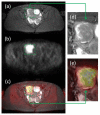Joint segmentation of anatomical and functional images: applications in quantification of lesions from PET, PET-CT, MRI-PET, and MRI-PET-CT images
- PMID: 23837967
- PMCID: PMC3795997
- DOI: 10.1016/j.media.2013.05.004
Joint segmentation of anatomical and functional images: applications in quantification of lesions from PET, PET-CT, MRI-PET, and MRI-PET-CT images
Abstract
We present a novel method for the joint segmentation of anatomical and functional images. Our proposed methodology unifies the domains of anatomical and functional images, represents them in a product lattice, and performs simultaneous delineation of regions based on random walk image segmentation. Furthermore, we also propose a simple yet effective object/background seed localization method to make the proposed segmentation process fully automatic. Our study uses PET, PET-CT, MRI-PET, and fused MRI-PET-CT scans (77 studies in all) from 56 patients who had various lesions in different body regions. We validated the effectiveness of the proposed method on different PET phantoms as well as on clinical images with respect to the ground truth segmentation provided by clinicians. Experimental results indicate that the presented method is superior to threshold and Bayesian methods commonly used in PET image segmentation, is more accurate and robust compared to the other PET-CT segmentation methods recently published in the literature, and also it is general in the sense of simultaneously segmenting multiple scans in real-time with high accuracy needed in routine clinical use.
Keywords: MRI-PET Co-segmentation; PET segmentation; PET-CT Co-segmentation; Random Walk; Simultaneous segmentation.
Published by Elsevier B.V.
Figures




















References
-
- Bagci U, Bai L. SIBGRAPI XX Brazilian Symposium on Computer Graphics and Image Processing. 2007. Multiresolution elastic medical image registration in standard intensity scale; pp. 305–312.
-
- Bagci U, Bai L. Proc. of SPIE Medical Imaging. 2008. Registration of standardized histological images in feature space; pp. 69142V–1.
-
- Bagci U, Bai L. Automatic best reference slice selection for smooth volume reconstruction of a mouse brain from histological images. IEEE Transactions on Medical Imaging. 2010;29:1688–1696. - PubMed
Publication types
MeSH terms
Grants and funding
LinkOut - more resources
Full Text Sources
Other Literature Sources
Medical

